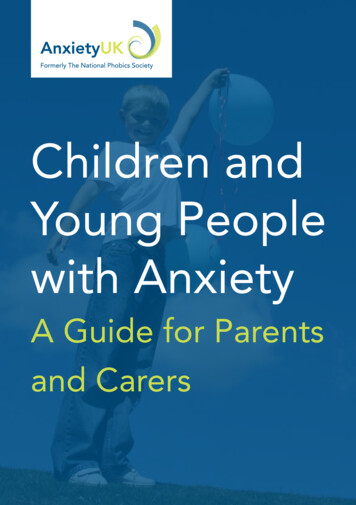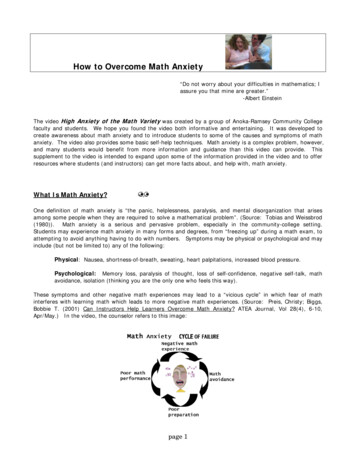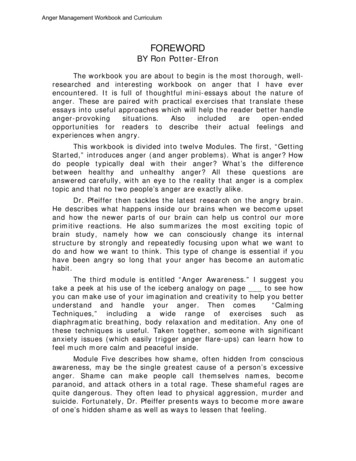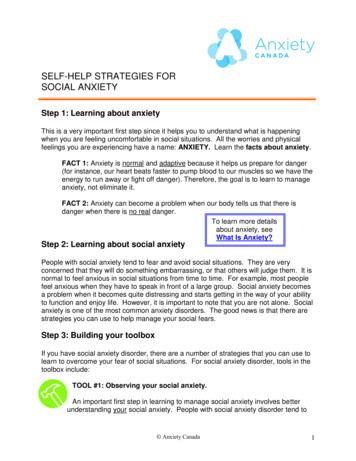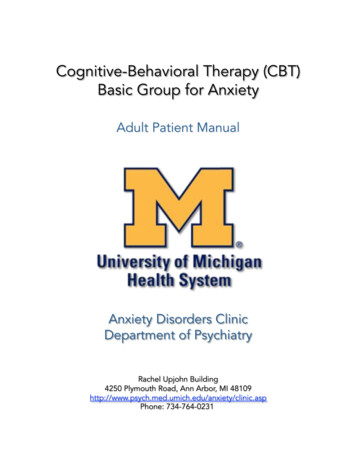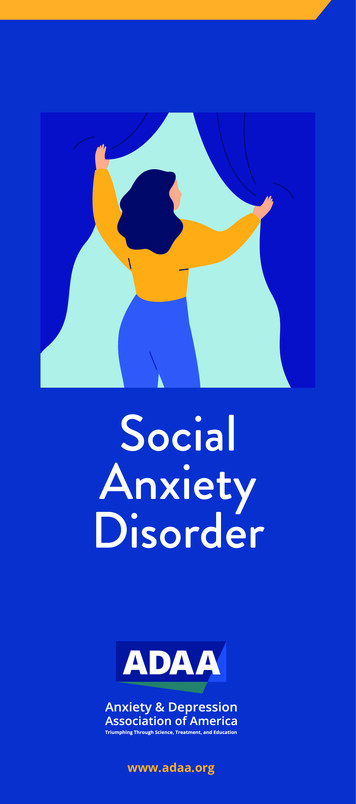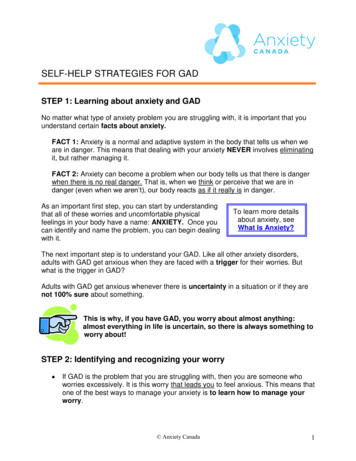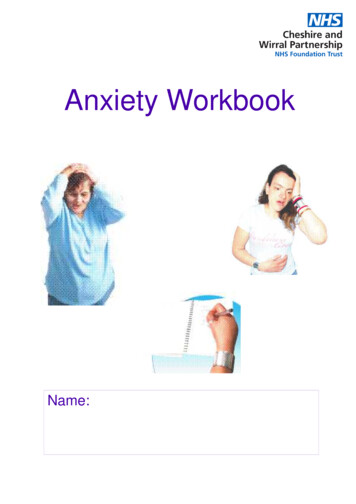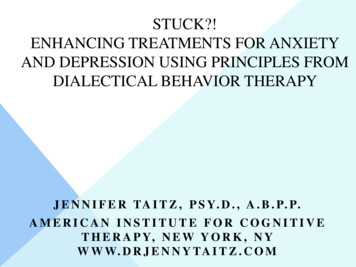
Transcription
STUCK?!ENHANCING TREATMENTS FOR ANXIETYAND DEPRESSION USING PRINCIPLES FROMDIALECTICAL BEHAVIOR THERAPYJ E N N I F E R TA I T Z , P S Y. D . , A . B . P. P.AMERICAN INSTITUTE FOR COGNITIVET H E R A P Y, N E W Y O R K , N YW W W. D R J E N N Y TA I T Z . C O M
“Here’s what I’ve tried: individual psychotherapy (three decades of it), family therapy,group therapy, cognitive-behavioral therapy, rational emotive behavior therapy,acceptance and commitment therapy, hypnosis, meditation, role-playing, interoceptiveexposure therapy, in vivo exposure therapy, self-help workbooks, massage therapy,prayer, acupuncture, yoga, Stoic philosophy, and audiotapes I ordered off a late-nightTV infomercial.And medication. Lots of medication. Thorazine. Imipramine. Desipramine.Chlorpheniramine. Nardil. BuSpar. Prozac. Zoloft. Paxil. Wellbutrin. Effexor. Celexa.Lexapro. Cymbalta. Luvox. Trazodone. Levoxyl. Inderal. Tranxene. Serax. Centrax. St.John’s wort. Zolpidem. Valium. Librium. Ativan. Xanax. Klonopin.Also: beer, wine, gin, bourbon, vodka, and scotch.Here’s what’s worked: nothing.” -- Scott Stossel, Surviving Anxiety, The AtlanticJanuary/February 2014
PREVALENCE AND COMORBIDITY 40 million adults in the U.S. suffer from an anxiety disorder (NIMH) More than half of people with one anxiety disorder have anotheranxiety disorder (Brown et al., 2001) Among individuals who attempt suicide, 70% have an anxietydisorder (Nepon, Belik, Bolton, & Sareen, 2010) Major Depressive Disorder affects approximately 14.8 million adults Nearly half of the people who have a major depressive episode willalso have an anxiety disorder (e.g. Reiger et al. 1998) In BPD populations, lifetime prevalence of depression occurs in asmany as 83% and anxiety disorders occur in as many as 88%
CURRENT CONCEPTUALIZATIONS Depression and anxiety share common factors (e.g. Fairholme, 2010) Research in affective science suggests moving toward examiningbroader shared constructs (e.g. Brown & Barlow, 2009) Common process emotion dysregulation Empirically supported treatments target emotion regulation The mechanism of change in DBTis reducing ineffective actionsassociated with dysregulated emotions.
WHAT MIGHT BE GETTING US STUCK? Problematic expectations-on both sides! Poor therapeutic alliance Premature dropout Patient hopelessness/low motivation Lack of generalization to real world Therapist burnout Too many problems to juggle
GOALS FOR TODAY1. Increase familiarity with Dialectical Behavior Therapy (DBT)2. Target potential stuck points using DBT principles3. Learn at least 5 DBT strategies to employ with your clients
OVERVIEW OF DIALECTICAL BEHAVIOR THERAPYComprehensive DBT includes:1. skills training2. individual therapy3. coaching calls4. team meetingsThese components aim to:1. enhance clients capabilities2. structure the environment to support the client3. generalize client gains4. heighten therapist motivation and competence*DBT is principle-based, not protocol- based*
EFFICACY OF DBT COMPONENTS BEYONDBPD Bulimia nervosa and binge eating disorder (e.g. Hill, Craighead, &Safer, 2011) ADHD (Hesslinger, 2002) Treatment resistant depression (Lynch et al., 2000, 2003; Harley,Sprich, Safren, & Jacobo, 2008) Depression in the elderly (DBT MED) (Lynch, Morse,Mendelson, & Robins, 2003) Post-traumatic stress disorder (Bohus et al., 2013) DBT-enhanced habit reversal for trichotillomania (Keuthen et al.,2011)
DBT FOR DEPRESSION 34 depressed adults over the age of 60 (M age 66.0, S.D 5.0)recruited from the Clinical Research Center for the Study ofDepression in Late Life at Duke Participants were randomly assigned to either an antidepressantcondition (MED) or medication 14 weeks of DBT skills training 30 minutes/week DBT phone coaching At post-treatment, 71% of MED DBT patients were in remission atpost-treatment compared to 47% of MED alone patients. At a 6-month follow-up, 75% of MED DBT patients were inremission compared to only 31% of MED patients.(Lynch, Cheavens, Cukrowicz, Thorp, Bronner, & Beyer, 2007)
TREATMENT INNOVATIONS WE’LL COVERTODAY Commitment strategies Validation Concrete skill instructions in distress tolerance and emotionregulation Extensive self-monitoring of emotions and skills
DIFFERENTIATINGB E H AV I O R T H E R A P I E S Exposure and responseprevention Skills training Reinforcement Cognitiverestructuring/distancing DBTCommitment strategiesValidation as a skill setMindfulness as a set of skills- e.g. wisemind, participateDialectical focusEmotion regulation and opposite actionskillsDistress tolerance skillsHigh therapist self-disclosureTelephone consultation
DBT ASSUMPTIONSABOUT THERAPY The most caring thing a therapistcan do is to help bring patientscloser to their ultimate goals Clarity, precision, andcompassion matter Principles of behavior affect boththerapists and clients-they areuniversal The therapeutic relationship is areal relationship between equalsA B O U T PAT I E N T S Patients are doing the best they can(and cannot fail in therapy)Patients want to improvePatients need to do better, tryharder, be more motivatedPatients may not have caused theirproblems, but need to solve themPatients must learn new behaviorsin all relevant contexts
BIOSOCIAL THEORYLinehan, 1993
THE BIOSOCIAL MODEL FOR DISORDERS OF OVERCONTROLLynch, Hempel, Dunkley, 2014
CASE EXAMPLES“Allison”“Mark”At intake (November, 2013, BDI35, BAI 56) four months later27-year-old male, long standingBDI 9, BAI 17)history of GAD, BDD, social28-year-old female, longstandinganxiety, MDD, OCPD, andhistory of generalized anxiety,physical pain. Presented onsocial anxiety, and perfectionism.medical leave, referred to meDeveloped panic disorder andfrom prescribing psychiatrist towas concurrently notablytarget SI.depressed and on medical leavefrom work.
BEHAVIOR THERAPY Change your thinking and your behavior Intense arousal, sense of invalidation What happens to the therapeutic relationship?Problem SolvingDialecticsValidation
DIALECTICAL PHILOSOPHY According to Hegel, truth as a process that develops when opposing,valid positions integrate into a finer truth Assumption there is no single truth. Effective use of dialectical strategies allow a provider to circumventa rigid argument, allowing a client to move towards goals.
DIALECTICS IN DBT Dialectics is both a theory and a stylistic approach aimed to targetdichotomous tendencies. Example of dialectical assumption in DBT: Clients are doing the bestthey can and they need to do better The need to simultaneously accept and change Dialectical philosophy also addresses a system as a whole DBT aims to treat whole patient rather than just the disorder. Alsowhole emotion system is targeted- all elements seen as interrelated.Linehan, 1993
ORIENTATION Ultimate treatment aim: “A life worth living” Informed consent to treatment/shared agreement on investment Treatment hierarchy: Life threatening Therapy interfering Quality of life-interfering
COMMITMENT STRATEGIES1.2.3.4.5.6.7.8.Evaluating the pros and cons of making a change“Foot in the door/Door in the face”Connecting present commitments to previous commitmentsUnderscoring freedom to choose and the absence of alternativesShapingCheerleadingDevil’s advocateAgreement on homeworkLinehan, 1993, p. 286-291
VALIDATION, DEFINED“The therapist communicates to the patient that her responses makesense and are understandable with her current life context orsituation.”“The therapist actively accepts the patient and communicates thisacceptance to the patient.”“The therapist takes the patient’s responses seriously and does notdiscount or trivialize them”--Linehan, 1993, Cognitive Behavioral Treatment of BorderlinePersonality Disorder, p. 222-223
WHY VALIDATE? To facilitate self-validation To reduce emotional arousal To strengthen the therapeutic relationship To balance change As feedback
LEVELS OF VALIDATION1. Staying awake- undivided listening and observing2. Providing accurate reflection3. Articulating the unarticulated emotions, thoughts, orbehavior patterns4. Validating in terms of past learn or biology5. Validating in terms of present context or normativefunctioning6. Radical genuineness
RADICAL ACCEPTANCE“To be fully open to what is, just as it is, at this verymoment ” Half-smiling Willingness Turning the mind Mindfulness of thoughts
CRISIS SURVIVAL A pit stop, not a destination Self soothing with the senses Activities, contributions,making meaning
MINDFULNESS Present, nonjudgmental, awareness Includes ability to differentiate betweenEmotion Mind, Reason Mind, Wise Mind What skills: observe, describe, participate How: nonjudgmentally, one mindfully, effectively
OPPOSITE ACTION1. Identify emotion2. Identify intensity of emotion3. Is emotion justified (fit the facts) in terms of theemotion and the intensity?4. Decide if you’d be willing to act opposite5. Do opposite action all the way, mind and body Aim is not to feel better, but to live bigger
EMOTION REGULATION Functions of emotions Motivate actions Communicate to self Communicate to others Understand the model of emotions Differentiate between primary and secondary emotions Reduce emotional vulnerability: Avoid avoiding! Challenge beliefs about emotions and interpretations Change an emotion by acting opposite Values exploration
INTERPERSONAL EFFECTIVENESS Attend to relationships, challenge interpersonal assumptions Learn to make requests, say no effectivelyDEAR MAN GIVE FAST Prioritize among:ObjectiveRelationshipSelf respect Practice validation Learn flexibility in way in which you make requests, say no
COMPREHENSIVE MONITORING
GETTING UNSTUCKPOTENTIALO B S TA C L E S Problematic expectationsPremature dropoutPoor therapeutic alliancePatient hopelessness/lowmotivation Lack of generalization to realworld Therapist burnout Too many problems to jugglePOSSIBLE DBTI N T E RV E N T I O N S Orientation, commitment strategies Validation, radical genuineness, therapistdisclosure Skills monitoring, validation, commitmentstrategies, crisis kits, coaching calls Skills monitoring, distress tolerance skills,coaching calls as needed Nonjudgmental stance, teams, appropriatedisclosure Hierarchy, skills training and monitoring
RECOMMENDED orgwww.dbtselfhelp.com
DIALECTICAL BEHAVIOR THERAPY JENNIFER TAITZ, PSY.D., A.B.P.P. AMERICAN INSTITUTE FOR COGNITIVE THERAPY, NEW YORK, NY WWW.DRJENNYTAITZ.COM “Here’s what I’ve tried: individual psychotherapy (three decades of it), family therapy, group therapy, cognitive-behavioral therapy
